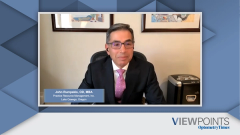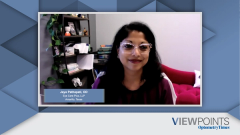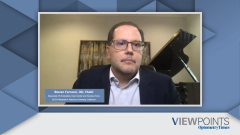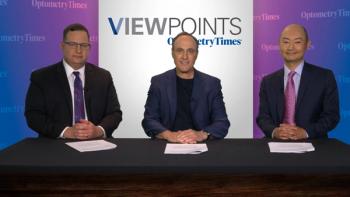
Managing AMD: Evaluating Remote Monitoring Center Data
The types of data provided by retinal monitoring centers and how to best utilize information provided to better treat patients who have dry age-related macular degeneration.
Episodes in this series

John Rumpakis, OD, MBA: Steve, stick with me for a second and picture the data that you receive back from the monitoring center and how you access it through the portal. Paint me a picture for those who are unfamiliar.
Steven Ferrucci, OD, FAAO: Working at the VA [Veterans Affairs Medical Center] things get more convoluted. Jaya would probably have a better answer to how it works in private practice, I think.
John Rumpakis, OD, MBA: OK, Jaya?
Jaya Pathapati, OD: Yes, I get a monthly report and it’s password protected. I open it and then I’ll see how many times they’re doing it, if there have been any changes. Obviously, if there was a change, I would be getting an alert from an email. But it’s seamless. Once you click on it, you can go in and do further evaluation. It has so much data, for me it was mind-blowing when I looked at it and I said, “Oh my gosh, this is pretty cool,” with the analysis as Steve was saying earlier. Even the chart of the metamorphopsia on the bottom, it’s phenomenal and it’s very easy. I can do it on my phone. I can do it on my desktop without any issues, so it’s terrific. I have had no issues. Initially, I thought, oh, this is going to take a lot of my time on top of everything. But it takes 5 minutes to peruse and make sure there’s nothing alerting me about a patient change, it’s nothing. It’s so easy. I was pleasantly surprised.
John Rumpakis, OD, MBA: From a proactive basis, you don’t have to get an alert, you can go into the portal and review data on a patient. Before a patient comes in, you can go into the portal, look at the historical tests that the patients take, and you can take a look at the metamorphopsia changes that have occurred over time up to the point that the alert occurred, right?
Jaya Pathapati, OD: Yes.
John Rumpakis, OD, MBA: You can spend some time reviewing a case prior to the patient ever coming in and having useful information that’s going to help your medical decision-making when that patient hits your office.
Jaya Pathapati, OD: Yes, absolutely.
Steven Ferrucci, OD, FAAO: If a patient has high blood pressure or diabetes and they have a monitor at home, they can check their blood pressure or blood sugar every day, and when they go see their doctor, they’re going to upload that ahead of time, and the doctor is going to look at what their blood pressure has been over the last 3 months. And that’s going to help them make a better decision about what they need to do next. Like you said, Jaya, it might be new in eye care, but this continuous monitoring is not that new in the medical field in general.
John Rumpakis, OD, MBA: The thing that’s revolutionary for eye care though is we’re talking about something that, normally we need to physically look in the eye, right? It’s always been a hands-on type of a disease state, and the concept that we can do remote retinal monitoring of a couple of different kinds, whether it’s through a visual field test or whether it’s through an OCT [optical coherence tomography] now, we start to think about how that technology has evolved. Whereas 20 years ago, OCTs were scarce and far in between in a practice, and now you can have one at home. That’s how far this technology has come.
Do you tend to put parameters or limits on the type of patients you would consider for home monitoring? Is it only individuals who may get to an intermediate stage or their acuity drops to 20/60 or worse? Is it a problem with access? Jaya, you’re saying some people drive 2-plus hours to see you. Steve, I’m sure sometimes with the VA population maybe it’s difficult to get in to see you. Maybe length of appointment time or waits, things like that can be an issue. Even from a patient education standpoint, is it something that you’re trying to struggle with the patient to understand how serious this is, and now you put them on home monitoring, that has some impact on how they perceive their own disease state?
Steven Ferrucci, OD, FAAO: Certainly you must have a discussion with the patient, and if it’s a patient who’s in denial about their disease process, it’s not going to work quite simply. It’s not that difficult to do quite frankly, and I’m amazed that after simple training, how many, even the older patients, because these are older patients, are able to do it successfully. It’s a high percentage, but obviously, you want a patient with certain cognitive capabilities. You don’t want to do it in someone who you just know there’s no way this guy is going to be able to do it.
John Rumpakis, OD, MBA: Sure.
Steven Ferrucci, OD, FAAO: I generally reserve it for patients with intermediate or worse disease. Per the studies, the studies had patients with 20/60 or better acuity; you want to think about that when you do it as well. The other set of patients it works super well in is a patient who might have wet macular degeneration in one eye and high-risk dry in the other eye because that’s a person who is motivated to do what they can to prevent their second eye from going bad. Those types of patients are very good candidates for remote monitoring.
Transcript edited for clarity.
Newsletter
Want more insights like this? Subscribe to Optometry Times and get clinical pearls and practice tips delivered straight to your inbox.













































.png)


